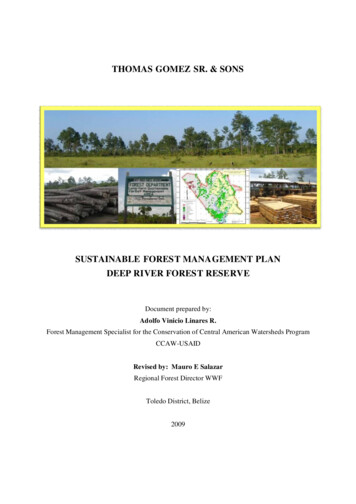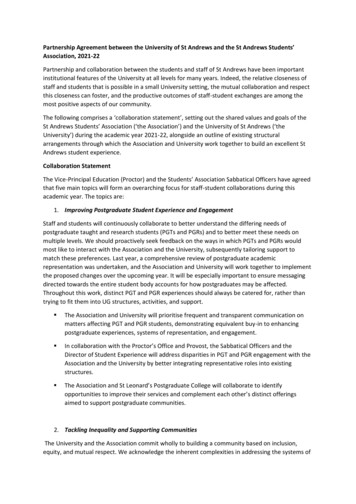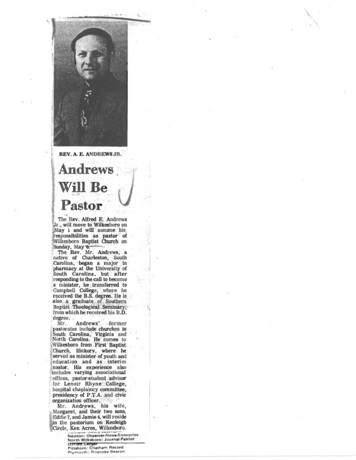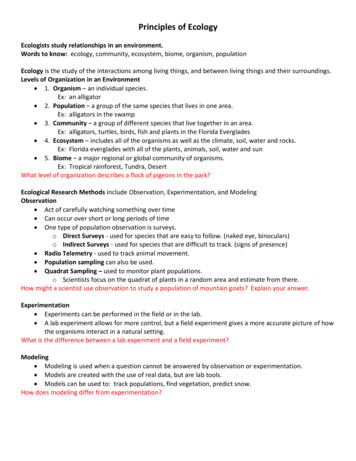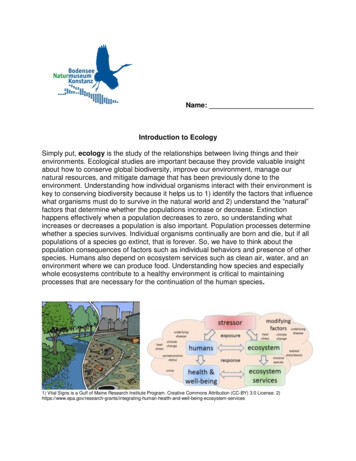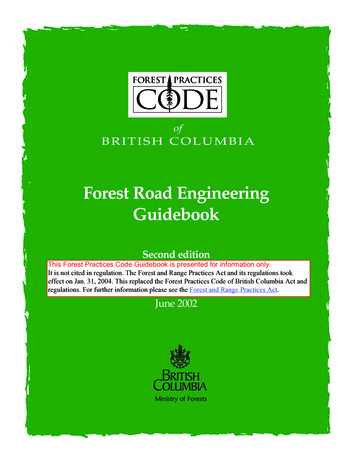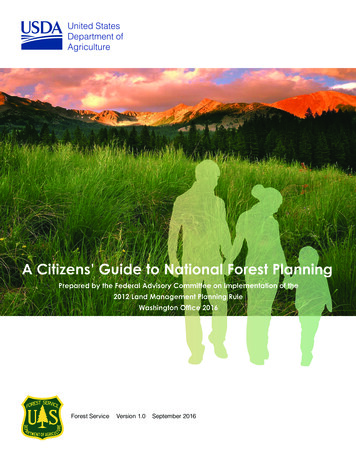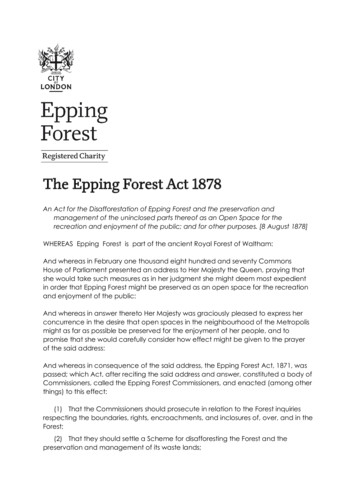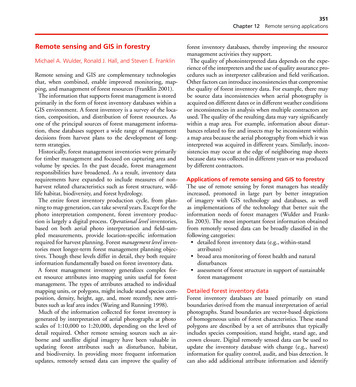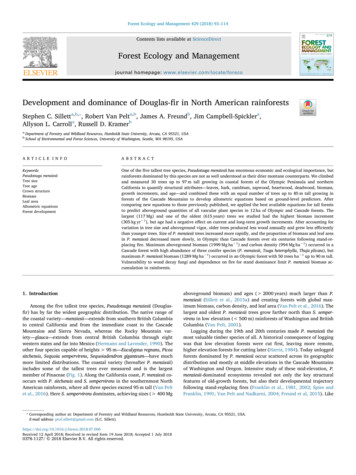
Transcription
Forest Ecology and Management 429 (2018) 93–114Contents lists available at ScienceDirectForest Ecology and Managementjournal homepage: www.elsevier.com/locate/forecoDevelopment and dominance of Douglas-fir in North American rainforestsa,b,⁎a,bbTaStephen C. Sillett, Robert Van Pelt , James A. Freund , Jim Campbell-Spickler ,Allyson L. Carrolla, Russell D. KramerbabDepartment of Forestry and Wildland Resources, Humboldt State University, Arcata, CA 95521, USASchool of Environmental and Forest Sciences, University of Washington, Seattle, WA 98195, USAA R T I C LE I N FOA B S T R A C TKeywords:Pseudotsuga menziesiiTree sizeTree ageCrown structureBiomassLeaf areaAllometric equationsForest developmentOne of the five tallest tree species, Pseudotsuga menziesii has enormous economic and ecological importance, butrainforests dominated by this species are not as well understood as their drier montane counterparts. We climbedand measured 30 trees up to 97 m tall growing in coastal forests of the Olympic Peninsula and northernCalifornia to quantify structural attributes—leaves, bark, cambium, sapwood, heartwood, deadwood, biomass,growth increments, and age—and combined these with an equal number of trees up to 85 m tall growing inforests of the Cascade Mountains to develop allometric equations based on ground-level predictors. Aftercomparing new equations to those previously published, we applied the best available equations for tall foreststo predict aboveground quantities of all vascular plant species in 12 ha of Olympic and Cascade forests. Thelargest (117 Mg) and one of the oldest (615 years) trees we studied had the highest biomass increment(305 kg yr 1), but age had a negative effect on current and long-term growth increments. After accounting forvariation in tree size and aboveground vigor, older trees produced less wood annually and grew less efficientlythan younger trees. Size of P. menziesii trees increased more rapidly, and the proportion of biomass and leaf areain P. menziesii decreased more slowly, in Olympic than Cascade forests over six centuries following stand-replacing fire. Maximum aboveground biomass (1999 Mg ha 1) and carbon density (994 Mg ha 1) occurred in aCascade forest with high abundance of three conifer species (P. menziesii, Tsuga heterophylla, Thuja plicata), butmaximum P. menziesii biomass (1289 Mg ha 1) occurred in an Olympic forest with 50 trees ha 1 up to 90 m tall.Vulnerability to wood decay fungi and dependence on fire for stand dominance limit P. menziesii biomass accumulation in rainforests.1. Introductionaboveground biomass) and ages ( 2000 years) much larger than P.menziesii (Sillett et al., 2015a) and creating forests with global maximum biomass, carbon density, and leaf area (Van Pelt et al., 2016). Thelargest and oldest P. menziesii trees grow farther north than S. sempervirens in low elevation ( 500 m) rainforests of Washington and BritishColumbia (Van Pelt, 2001).Logging during the 19th and 20th centuries made P. menziesii themost valuable timber species of all. A historical consequence of loggingwas that low elevation forests were cut first, leaving more remote,higher elevation forests for cutting later (Harris, 1984). Today unloggedforests dominated by P. menziesii occur scattered across its geographicdistribution and mostly at middle elevations in the Cascade Mountainsof Washington and Oregon. Intensive study of these mid-elevation, P.menziesii-dominated ecosystems revealed not only the key structuralfeatures of old-growth forests, but also their developmental trajectoryfollowing stand-replacing fires (Franklin et al., 1981, 2002; Spies andFranklin, 1991; Van Pelt and Nadkarni, 2004; Freund et al, 2015). LikeAmong the five tallest tree species, Pseudotsuga menziesii (Douglasfir) has by far the widest geographic distribution. The native range ofthe coastal variety—menziesii—extends from southern British Columbiato central California and from the immediate coast to the CascadeMountains and Sierra Nevada, whereas the Rocky Mountain variety—glauca—extends from central British Columbia through eightwestern states and far into Mexico (Hermann and Lavender, 1990). Theother four species capable of heights 95 m—Eucalyptus regnans, Piceasitchensis, Sequoia sempervirens, Sequoiadendron giganteum—have muchmore limited distributions. The coastal variety (hereafter P. menziesii)includes some of the tallest trees ever measured and is the largestmember of Pinaceae (Fig. 1). Along the California coast, P. menziesii cooccurs with P. sitchensis and S. sempervirens in the southernmost NorthAmerican rainforests, where all three species exceed 95 m tall (Van Peltet al., 2016). Here S. sempervirens dominates, achieving sizes ( 400 Mg⁎Corresponding author at: Department of Forestry and Wildland Resources, Humboldt State University, Arcata, CA 95521, USA.E-mail address: prof.sillett@gmail.com (S.C. 006Received 12 April 2018; Received in revised form 19 June 2018; Accepted 1 July 20180378-1127/ 2018 Elsevier B.V. All rights reserved.
Forest Ecology and Management 429 (2018) 93–114S.C. Sillett et al.Fig. 1. Historical photographs of P. menziesii. (a)The largest individual ever recorded, which grewat 440 m elevation in Lewis County, Washington,was reliably measured at 119.8 m tall and469 cm DBH (Carder, 1995; Van Pelt, 2001). Inaddition to total height and lower trunk diameters, a diameter of 183 cm at 68.6 m above theground was measured on the snapped top in1908 and verified by an independent observer in1924 (Boland 1927 photograph from McArdleand Meyer (1930)). (b) After the tree toppled in1930, a 305-cm-diameter cross section was cutfrom a height of 18.4 m. This sample remainspreserved today at the Wind River Arboretumand has 865 rings (Silen and Olson, 1992). (c)The only known photographic evidence of anentire tree larger than any P. menziesii alivetoday is of this 494-cm-DBH individual growingat 100 m elevation in Skagit County (WashingtonState Historical Society, Tacoma). Note peoplestanding at tree bases for scale.2014), the cohort gains height rapidly, retaining model-conformingcrowns until damaged. Following canopy closure, crown depths contract through self-pruning, and trees jostle for social position. Crowns ofdominant trees eventually deepen via epicormic branching as neighborssuccumb to mortality and light penetration of the canopy increases.Decapitation of treetops and branch tips in storms eventually leads totrunk reiteration and limb formation (see Sillett et al., 2018). Cumulative effects of damage and reiteration over centuries lead to individualized crown structures in old-growth forests. Decay fungi drivedensity-independent tree mortality during later centuries (Bible, 2001),ultimately determining P. menziesii longevity. Ring counts of felled treesreveal that maximum longevity of P. menziesii is 1000 years in rainforests (Stoltmann, 1993; Carder, 1995), about twice as long as P.sitchensis and half as long as S. sempervirens.Understanding of P. menziesii tree and forest development is biasedtowards the Oregon and Washington Cascades, where the vast majorityof research on unlogged forests has occurred. These Cascade forests donot support trees as tall, large, or old as those known from coastalforests at lower elevations (Carder, 1995; Van Pelt, 2001). Except for afew protected areas on the western Olympic Peninsula and in northernCalifornia, coastal rainforests with trees 95 m tall are virtually gone.To our knowledge, no intensive study of P. menziesii in these forests hasE. regnans but less extreme (Tng et al., 2012; Sillett et al., 2015b), P.menziesii requires fire for prolific regeneration in rainforests and generally fails to establish stand dominance unless much of the previouscohort is killed. If unable to reproduce, P. menziesii is gradually replacedby other species and will ultimately disappear from stands if the interval between fires is 1000 years. Across a large portion of its nativerange, however, surviving old-growth forests have multiple P. menziesiicohorts as a consequence of moderate-severity fires that kill only someof the previous cohort and allow P. menziesii to re-establish (Zenner,2005; Tepley et al., 2013). In the wettest part of its distribution, longfire-return intervals preclude development of localized seed sources andpromote development of extensive forests dominated by other coniferswith higher shade-tolerance and lower fire resistance, especially P.sitchensis, Tsuga heterophylla, and Thuja plicata (Franklin and Dyrness,1988; Beach and Halpern, 2001; Van Pelt, 2001, 2007; Stolnack andNaiman, 2010).Even if P. menziesii trees escape or survive fire over centuries, theircrowns inevitably sustain injuries through the violence of storms.Arboreal investigations in Cascade forests of Oregon (Pike et al., 1977)and Washington (Ishii and Ford, 2001; Ishii et al., 2002, 2017; Van Peltand Sillett, 2008) defined the development of P. menziesii crownstructure. After a multi-decadal establishment period (Freund et al.,94
Forest Ecology and Management 429 (2018) 93–114S.C. Sillett et al.Table 1Characteristics of ten locations in Washington (WA) and California (CA) where 60 trees were climbed to develop allometric equations for P. menziesii along withindependent location in Oregon (OR, 11). Locations within region are ranked by decades since stand-replacing fire (if known). California location (5) in HumboldtCounty is dominated by S. sempervirens in silvatic mosaic subjected to small-scale disturbances, where stand age becomes irrelevant (Van Pelt et al., 2016). Trees inone Olympic location (1) regenerated after clearcut logging in early 20th century. All other locations are dominated by P. menziesii presumably established afterstand-replacing fires. Precipitation and temperature values reflect long-term averages (PRISM and Western Regional Climate Center). Ownerships include Washington Department of Natural Resources (DNR), United States Forest Service (USFS), National Park Service (NPS), and California State Parks (CSP). Trees indicatenumber of individuals climbed within reference plots established in eight locations with additional trees climbed near plots in three locations (2, 3, 4). Oregonlocation is aggregate of three plots established for study of spatial patterns in understory vegetation (Van Pelt and Franklin, 2000).Precipitation (cm)Temperature ( C)LocationStateRegionOwnershipStand age(decades)Latitude ( N)Longitude ( W)Elevation (m)AnnualSummerSnowWinter TminSummer 652951211310 3 11 .602.302.921.0924451566666–heartwood, and biomass for use in developing allometric equations.Tree growth increments were calculated using a three-dimensionalframework of physical measurements combined with crossdated annualring widths. All aboveground vegetation within plots was measured in aspatially explicit manner to quantify biomass and leaves of vascularplants via allometric equations derived from this study and the published literature.been made. Moreover, all existing allometric equations used to predictphysical quantities of P. menziesii are based on trees 85 m talland 3 m diameter. Intensive study of much larger S. sempervirens andS. giganteum revealed that biomass increments continue to increase withtree size for over 2000 years and that old age has little direct effect ontree-level productivity (Sillett et al., 2015a). Whether this is true in P.menziesii, and if coastal forests dominated by P. menziesii hold morebiomass and leaf area than comparable Cascade forests, remain unknown.Here we make the first intensive measurements of P. menziesii incoastal rainforests (Washington and California) and evaluate the effectsof tree structure and age on aboveground productivity for comparisonwith other tall species recently studied using the same methods. Wethen develop new allometric equations for P. menziesii in coastal andCascade forests, compare them with existing equations, and apply thebest available equations to all vascular plants within vegetation plotsestablished in single-cohort, P. menziesii-dominated forests. We selectedthese locations to form a pseudo-chronosequence for examination ofOlympic and Cascade forest development after stand-replacing fire. Wehave three specific questions: (1) How do P. menziesii trees in coastalforests differ from those reaching comparable heights in Cascade forestswith respect to crown structure? (2) After accounting for variation incrown structure, does age have any additional effect on annual growthincrements of P. menziesii? (3) In the centuries following disturbance,do P. menziesii-dominated forests develop similar canopy structures andrates of biomass accumulation in Olympic and Cascade locations?2.2. Study areaFrom March 2014 to March 2016, we established three vegetationplots in P. menziesii-dominated forests of different age classes on thewestern Olympic Peninsula of Washington to quantify forest structureand initiate longer-term measurements of forest dynamics (see Plotmeasurements). These forests experience a maritime climate accentuatedby cool, wet winters and warm, dry summers. Precipitation at lowelevations occurs primarily as rain between October and April, exceeding 300 cm annually. Forests dominated by P. menziesii are usuallyconfined to steep slopes above alluvial terraces where P. sitchensis andT. heterophylla prevail, except in a few isolated areas that experiencedhigh-severity fire (Franklin and Dyrness, 1988). Typically occurringduring summer on south-facing slopes (Huff and Agee, 1980; Van Pelt,2007) or associated with dry east winds (Henderson et al., 1989), firesare rare in these forests. Wind is the predominant disturbance agent,usually happening in large-scale events with several hurricane-forcestorms recorded since 1788 (Henderson et al., 1989).We selected published datasets for comparison with Olympic forests thatincluded six locations in the western Cascade Mountains of Washington andOregon. Within each location, plot-level measurements were taken for trunkdiameter, height, and crown size of all trees as well as spatially explicitsampling of understory vegetation (Van Pelt and Franklin, 2000; Van Peltand Nadkarni, 2004; Van Pelt and Sillett, 2008). These Cascade forests aredominated by P. menziesii and include substantial quantities of other conifers, especially T. heterophylla and T. plicata. The climate is maritime withcool, wet winters and warm, dry summers, but these forests receive lessannual precipitation with greater proportions as snow than Olympic forests(Table 1). Prehistoric disturbance regimes in the Cascade forests we selectedwere characterized by single, high-severity wildfires leading to replacementof P. menziesii cohorts (Hemstrom and Franklin, 1982; Agee, 1993). Weavoided forests with more than one P. menziesii cohort to isolate standsinitiated after a single disturbance event.2. Methods2.1. OverviewWe combined crown mapping and limited destructive sampling toquantify branch components of 60 P. menziesii trees, used incrementcores to determine trunk tissue volumes and densities, analyzed annualrings to quantify trunk ages and growth increments, and compiled intensive measurements of vegetation across 12 ha of forest. Our effortspanned spatial scales from leaf to plot, so we employed hierarchicalsampling based on complete, nondestructive inventories as in previouswork (Sillett et al., 2010, 2015a,b, 2018; Van Pelt et al., 2016). We paidspecial attention to within-tree variation to achieve a high degree ofaccuracy in aboveground estimates of leaves, bark, cambium, sapwood,95
Forest Ecology and Management 429 (2018) 93–114S.C. Sillett et al.randomly selected pieces of each foliar unit, we used paired calipermeasurements to quantify bark and wood radii at 1-cm diameter intervals as well as piece length. After computing fresh volumes, bark andwood portions were oven-dried at 101 C to compute densities. Wesubsampled twigs 1 cm diameter by randomly selecting about a thirdof the material for measurements of distal diameter—average of fivecaliper readings beneath terminal buds—and path length. Ten freshleaves were randomly selected from each subsample, digitally scannedat 600 dpi to quantify silhouette area, oven-dried, and weighed tocompute specific leaf area (m2 kg 1). For twigs 1 cm, all material ofeach foliar unit was oven-dried and weighed, and mass ratios were usedto convert subsample to total path length. After drying, leaves weremanually separated from twigs and weighed separately. All thesemeasurements were combined to compute the following quantities foreach foliar unit: bark volume, wood volume, bark mass, wood mass,bark area, cambium area, leaf mass, leaf area, and number of leaves. Weused 40-sample means and standard errors as multiples to calculatefoliar unit quantities of all branches on Olympic trees.In California and Cascade locations, smaller foliar units were recognized while mapping trees, so we based calculations on independentsamples. In California, 23 foliar units averaging 1.7 cm basal diameterwere collected from 14 trees 20–89 m above the ground. At twoCascade locations (9, 10), 38 foliar units averaging 2.5 cm basal diameter were collected from 15 trees 21–79 m above the ground. Thesefoliar units were dissected using methods similar to the Olympic effortexcept that samples were not separated into 1-cm-diameter pieces formeasurements of path lengths, radii, and densities. We used Olympicdata to predict these quantities separately for California and Cascadefoliar units (Appendix A). At three Cascade locations (6, 7, 8), foliarunits were not counted, because foliage quantities in the previous studywere based on equations resulting from dissection of branches 2–10 cmbasal diameter whose leaves were removed, dried, and weighed (VanPelt and Sillett, 2008). Here we predicted the number of foliar units perbranch in these locations as a power function of basal diameter usingdata from 22 branches (Appendix A). The vertical gradient of specificleaf area was inconsistent among locations, so we used independentequations to convert leaf mass to area for foliar units at Olympic, California, and Cascade locations (Appendix A).Tissue components of branches 4 cm diameter were predictedusing equations derived from dissection of freshly fallen material. Weused a hand saw to collect pieces (4–25 cm diameter, 14–41 cm length)from 25 branches (16 Olympic, 9 California). After measuring eachpiece for length and diameter, we used paired caliper measurements toquantify bark, sapwood, and heartwood radii at cut ends. These datawere used to develop equations for predicting bark and wood radii asfunctions of total radius (Appendix A). After calculating fresh volumes,bark and wood portions were oven-dried at 101 C to compute densities(Appendix A).2.3. Tree selectionOver half of the P. menziesii trees we climbed grow within vegetation plots established in this and previous studies (Table 1). EachOlympic plot had three trees selected for detailed study, and six additional trees were chosen in nearby forests, including one regeneratingafter clearcut logging in the 20th century. In northern California, weselected 15 trees from old-growth forest in Prairie Creek RedwoodsState Park dominated by S. sempervirens. We stratified selection of thesetrees on the basis of height such that five were 59–66 m, five were73–80 m, and five were 91–97 m tall. In the Washington Cascades, weselected 30 trees from mid-elevation (410–730 m) P. menziesii-dominated forests of five age classes (Table 1). These trees were a subset of70 trees from seven age classes (Van Pelt and Nadkarni, 2004), excluding individuals with dead tops as well as two forests deemed incapable of developing canopy heights 70 m (i.e., Trout Creek andadjacent plantation; Van Pelt and Sillett, 2008). Thus, our dataset included 30 trees from coastal forests in Washington (climbed2014–2016) and California (climbed 2006) and 30 trees from Cascadeforests in Washington (climbed 2001–2002). The 60-tree sample included dominant and suppressed individuals in each region, excludingtrees deemed unsafe to climb because of tiny branches, excessive lean,or extensive decay.2.4. Crown mappingUsing modern arborist-style rope techniques, we crown-mappedtrees as described previously (Van Pelt et al., 2004; Van Pelt and Sillett,2008; Sillett et al., 2010, 2015a,b, 2018). Main trunks were tapemeasured for diameter at 5-m intervals above buttressing. From topof buttress (TB), where the trunk is mostly round, to ground level, weconverted tape diameter (tape D) to functional diameter (f-D) at multiple heights, including breast height (BH 1.37 m), via footprintanalysis (Van Pelt et al., 2016). Branches larger than a minimum diameter (4 cm) were measured for height above ground, base diameter,path length (i.e., distance along branch to the minimum diameter, including laterals and forks), horizontal extension, azimuth, slope in degrees relative to horizontal, and number of foliar units. Foliage of P.menziesii occurs in discrete units that can be counted to the nearesttenth unit with proper calibration. Because counting of foliar unitsoccurred over 15 years by different sets of calibrated climbers, wequantified foliar units via independent dissections in Olympic, California, and Cascade locations (see Branch sampling). Broken branches,portions of appendages proximal to unbroken branches, limbs, andreiterated trunks were mapped as segments that each received base,top, and supplemental (if necessary) measurements of diameter andheight as well as distance and azimuth from a mapped reference. Weaccounted for missing bark, cambium, and sapwood by visually estimating the dead proportion of each branch and segment. As describedpreviously (Sillett et al. 2015b), we created computer models for eachtree to screen for errors prior to making size calculations.2.6. Trunk samplingFrom the 15 Olympic trees, we collected 205 increment cores frommain trunks in pairs at BH, TB, and 10–20 m height intervals up to87.5 m. Attempts were made to reach pith at all height intervals exceptBH and TB, and single cores were collected when the borer reachedcambium on the opposite side of the trunk. As described previously,increment cores were mounted, sanded, digitally scanned to quantifyring widths, and crossdated (Carroll et al., 2014), yielding 41,180 annual rings extending back to the year 1412. Bark radius from each corewas measured by inserting a probe into the hole, finding cambium, andmeasuring distance along probe from cambium to the convex hull of adiameter tape. Sapwood radii were measured from cambium to heartwood using color differentiation at the sapwood/heartwood boundary.Heartwood radii were computed as total radius minus average barkradius minus average sapwood radius at each sampling height. Averagewood and heartwood radii (m) were regressed against trunk total radius2.5. Branch samplingIn the Olympic trees, we defined foliar units as branches or portionsof branches 4 cm diameter. Thus, larger branches had multiple foliarunits, while individual smaller branches arising from segments or themain trunk had 1. From treetop to lowest living branch, crowns of 10trees were divided into quartiles on the basis of height, and one foliarunit was randomly selected from each quartile to yield 40 destructivesamples of exactly 4 cm basal diameter distributed across the heightgradient (28–87 m). After removal with a hand saw, we bagged foliarunits and lowered them from the crown for dissection in the laboratory,where stems were cut at 1-cm diameter intervals to isolate size classesof unbranched pieces that were then laid end to end for measurement ofnon-overlapping path length to the nearest cm. From freshly cut ends of96
Forest Ecology and Management 429 (2018) 93–114S.C. Sillett et al.Pathlength (cm) 0.529773 BD1.605359 (d 1 D 1),(1)where BD is basal diameter (cm) of branch, d is distal diameter (cm) of1-cm interval, and D is basal diameter (cm) of 1-cm interval.For California and Cascade trees, we applied this equation to estimate path lengths of 2–3 and 3–4 cm diameter intervals for each branchand thus bridge the gap between foliar units and components 4 cmdiameter at these locations. Above 4 cm diameter for all trees, wepartitioned branch path length into 1-cm diameter intervals using Eq.(1), computed the proportion of each size class, and multiplied theseproportions by measured path length 4 cm diameter to estimatelength of each size class. We combined the resulting path lengths withmeasured and predicted radii and densities to compute volumes, surface areas, and masses of bark, cambium, sapwood, and heartwood forall branch components 4 cm diameter.Tissue components of segments were quantified by applying conicequations to measured lengths, measured radii for total volume andbark area, and predicted radii for cambium, sapwood, and heartwood.Visually estimated dead proportions were used to downscale livingcomponents. Dead volume was computed as the sum of dead bark anddead wood to ensure that total volume equaled the sum of bark, wood,and dead volume. We converted volumes to masses using the followingmeasured densities for branches 4 cm diameter: bark 408,wood 544, total 501 kg m 3 (Appendix A), where total densitywas used to convert dead volume to mass.Fig. 2. Density of P. menziesii sapwood and heartwood as quadratic functions ofheight. Values are means 1 SE (N 4–13 trees per height interval). Equationsare in Appendix A.(m) or height (m) to predict these radii at all heights (Appendix A), andbark radius was computed as total radius minus wood radius. Afterregressing measured against predicted radii, we used linear relationships to adjust predicted values for each tree, which improved calculations for trees with unusually thin or thick bark or sapwood for agiven trunk size (Sillett et al., 2015a).We collected additional cores at 10-m height intervals from 13trees (excluding 4, 14) to quantify wood density. Freshly collectedcores were separated into sapwood and heartwood portions andimmediately sealed in airtight tubes. After determining fresh volumes of cores by the Archimedes principle, cores were oven-dried at101 C and weighed to the nearest 0.0001 g. Average sapwood andheartwood densities at 10-m height intervals (N 4–13 trees) werethen regressed against height (N 8 heights up to 80 m), yieldingseparate equations to predict wood densities as functions of height(Fig. 2, Appendix A) for the 47 trees we did not core-sample. Wooddensities of the 13 sampled trees were predicted using tree-specificequations or means if no relationship between height and densitywas evident. Because main trunk bark density could not be determined via core sampling, we used handsaw, chisel, and hammer toremove six bark samples (1072–7364 cm3) from various trunk diameters (27–129 cm) of freshly fallen trees 1 m DBH near the SolDuc River in Olympic National Park. After oven-drying at 101 C andweighing, we obtained a mean tissue density of 317 kg m 3 for bark,compared to mean densities of 363 and 400 kg m 3 for sapwood andheartwood, respectively (Appendix A).2.8. Age calculationsIncrement cores not reaching pith often yielded sufficient evidencein ring curvature to estimate number of years to pith and thus determine trunk age as the sum of annual rings, but this was impossible onlarge trees. We developed equations to predict ring width as powerfunctions of wood radius at 10, 20, 30, 40, and 50 m using data from all15 Olympic trees. After subtracting bark, the sampled portion of eachtrunk’s wood radius was determined for year of sampling and allcrossdated years by subtracting ring widths sequentially. Prior to thiswe averaged ring widths for each pair of cores. The resulting time series(N 75) of ring widths (mm) and wood radii (m) extending to theinnermost rings reached by coring were divided into quartiles, whoseaverages were computed and used to develop equations at each height(Table 2). These equations used all available evidence to provide reasonable estimates of ring widths as pith was approached. When pithwas not reached by coring, the remaining wood radius was divided intoannual increments by sequentially subtracting predicted ring widths,and trunk age was determined by counting all measured and predictedring widths from cambium to pith. We regressed height (x) at 10-mintervals up to 50 m against trunk age (y), and the y-intercept of thislinear relationship became the estimate of tree age (i.e., trunk age atground level).Tree structure, age, and recent growth—As in our previous studies of P.menziesii (Van Pelt and Sillett, 2008) and other tall species (Sillett et al.,2010, 2015a,b), a primary matrix of aboveground attributes describingtree size, branches, and tissue ratios was generated for the 60 trees andsubjected to principal components analysis using a correlation cross-2.7. Size calculationsCrown mapping and sampling yielded spatially explicit informationfor all aboveground tree components. We used these data to computesurface areas, volumes, and masses of bark, cambium, wood, and leavesas described previously (Sillett et al., 2015a,b) with size calculationsdiffering for branches, segments, and main trunks. We calculated maintrunk bark, sapwood, and heartwood masses by applying predicteddensities to the midpoint height of each trunk frustum.After summing the number of foliar units per tree and computingfoliage quantit
imum biomass, carbon density, and leaf area (Van Pelt et al., 2016). The largest and oldest P. menziesii trees grow farther north than S. semper-virens in low elevation ( 500m) rainforests of Washington and British Columbia (Van Pelt, 2001). Logging during the 19th and 20th centuries made P. menziesii the most valuable timber species of all.
